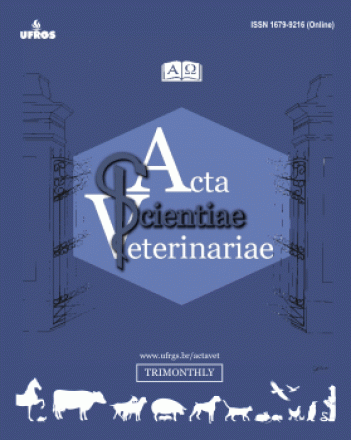Descrição de quatro casos de atrofia do pâncreas exócrino em cães
Acta Scientiae Veterinariae
Descrição de quatro casos de atrofia do pâncreas exócrino em cães
Autor Correspondente: David Driemeier | [email protected]
Palavras-chave: cães, pâncreas, atrofia exócrina, insuficiência
Resumos Cadastrados
Resumo Inglês:
Background: Exocrine pancreatic atrophy (EPA) is characterized by marked decrease of the exocrine pancreatic tissue in dogs,
the disease is more frequently described in German Shepherd Dogs and there are features of herdability in this breed. Clinical
signs observed are those typical of chronic pancreatic insufficiency, including voluminous stool, steatorrhoea and weight loss.
The purpose of this paper is to describe clinical and pathological findings of four cases of EPA in dogs.
Cases: Files of all necropsies performed in dogs in the Veterinary Pathology Laboratory of the Universidade Federal do Rio
Grande do Sul (UFRGS) between January, 2001 and December, 2010 were reviewed, searching for EPA cases. Were collected
information about age, breed, clinical signs, evolution of the disease, and pathological findings of the cases that were found.
Pancreatic portions of the affected dogs were submitted to immunohistochemistry (IHC) using polyclonal antibodies against
cytokeratin and chromogranin, labeled with streptavidin-biotin linked to peroxidase method and red chromogen were applied.
Hematoxylin was used for counterstaining. During the period analyzed four cases were found, representing a small percentage
(0.9%) of dog cases with post-mortem examination during the period. Two dogs were German Shepherd Dogs, one male and
one female, both aged three years. The other two dogs were mixed breed females with one and two years of age. Clinical course
of the disease varied between five months and one year and the main clinical signs presented were: pale and voluminous feces
(4/4), weight loss (4/4), recent loss of appetite (2/4), vomiting (1/4) and polydipsia (1/4). Loss of appetite was noticed one week
before death. Feces of all animals were tested for fecal protease (trypsin), and all resulted negative. In one case feces were also
evaluated for fecal amylase and lipase, resulting negative for both enzymes. Gross lesions observed were: pancreatic tissue
extremely diminished, semi-transparent and narrow (4/4), decreased muscular tissue volume (4/4), diminished subcutaneous
adipose tissue (4/4), intestine filled with soft, voluminous and pale feces (4/4). Microscopically, pancreas presented absence
of acinar structures, containing rare epithelial cells scattered throughout the parenchyma, essentially composed of Langerhans
islet cells, surrounded by pancreatic ducts and evident supportive stroma. Lymphocytic multifocal mild infiltrate and adipose
infiltrate were observed in two cases. Multifocal muscle fiber atrophy occurred in all four cases, in one of them it was associated
with hyaline and flocular degeneration of muscle fibers. Remaining cells of pancreatic tissue were positive for chromogranin
IHC, staining granular material inside the cells, showing the neuroendocrine tissue. Cytokeratin IHC stained rare remaining
acinar cells and duct cells.
Discussion: EPA diagnosis of the presented cases was performed based on clinical history, pathological findings and IHC
staining. EPA cases shall be considered as causes of weight loss, chronic presentation of voluminous pale feces and death in
young German Shepherd Dog. The lack of familiar history among mongrel dogs makes difficult to assess the susceptibility of
these dogs to EPA, and it should be considered a differential diagnosis in cases presenting the clinical signs highlighted in this
paper.

